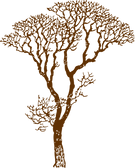



The timber we use
Here you can find out a little bit about of info on the timbers we use to create our great handcrafted products!

Blackwood (Acacia Melanoxylon)
Blackwood is a member of the wattle tree family and a hardwood. It occurs throughout Tasmania's native forests from sea level to 1000m in elevation but it thrives in swamp and riverine areas. It is also a common understorey componet of wet eucalypy forest.
The swamps of the northwest of Tasmania, where there are almost pure stands, have been a primary source of high quality blackwood for more than a century. Blackwood has been the cornerstone of Tasmania's fine furniture industry over that time, some of which can be seen at the Tasmanian Museum and Art Gallery.
Huon Pine (Lagarosrobos Franklinii)
Huon Pine is the prince of Tasmanian timbers. The richness of its golden colour and figure make it one of the world’s most desirable furniture and veneering timbers. Its durability and workability make it one of the best boat-building timbers known. The wood contains a natural preserving oil with an unmistakable perfume, and its fine and even grain makes the wood exceptionally beautiful.
Huon pine is found in Tasmania’s cool temperate rainforests and grows along riverbanks, lakeshores and swampy locations – it generally likes its feet in the water. It can be found from sea level to about 800m, but mainly below 150m.


Myrtle (Nothofagus Cunninghamii)
Myrtle belongs to the same family as the beeches of Europe. It is found in any of the wet forests across Tasmania, more frequently in the north west and west of the State. Providing conditions are moist and sheltered, the tree flourishes from sea level to the tree line.
Myrtle is a striking wood with rich red, brown and almost orange tones. It's believed the richness of the colour comes from the quality of the soil it grows in. The deepest red myrtle comes from highly fertile soil on basalt (volcanic rock).
Sassafras (Atherosperma moschatum)
Of all Tasmanian timbers, sassafras has the most variable and dynamic colouring. It is a beautiful and pale creamy grey to white normally but can be streaked with rich browns and black heart. So, it is available in two major groupings; Golden sassafras and Blackheart sassafras.
Sassafras can be found in Tasmania’s native forests. It generally grows in well-drained rainforests in cool damp conditions, where it is one of the dominant species. Sassafras prefers gullies and along creek lines and grows from sea level to around 800 metres.
